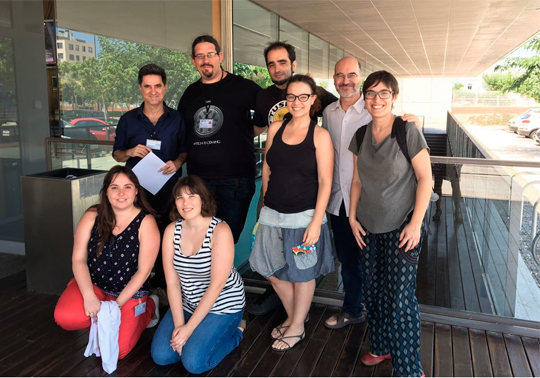A study describes for the first time the neural connections of the emotional processing of the olfactory stimuli in mice
- July 18th, 2017

The Lab of Functional Neuroanatomy of the University of Valencia and Jaume I de Castellón has described for the first time the complete map of the neural connections of the anterior cortical amygdaloid nucleus, which is a key brain region for the emotional process of the olfactory stimuli. The work has been published in the magazine ‘Journal of Comparative Neurology’.
Bernardita Cádiz, María Abellán, Cecília Pardo, Ferran Martínez and Enrique Lanuza form the research team that has described the nervous system of the anterior cortical amygdaloid nucleus, which was unknown until now. The paper describes the relationship between this nucleus and the other structures from which it receives the information, as well as the brain areas to which it sends information.
Enrique Lanuza, researcher of the Department of Cellular Biology, Functional Biology and Physical Anthropology of the Universitat de València, highlights that the olfactory information has an intrinsic emotional value. ‘This paper shows that this information directly arrives at the anterior cortical amygdaloid nucleus. It is directly interconnected with areas that process the pheromonal information (which plays a key role in the sexual behaviours in rodents) and also with nucleus related to defensive and aggressive behaviours’, says the expert.
Moreover, the member of the Lab of Functional Neuroanatomy affirms that this olfactory nucleus of the amygdala is connected to areas that are involved in the Pavlovian learning as it has been proved. This kind of learning consists in linking a neutral stimulus to a reward or a negative experience.
‘Even though the experiments were conducted with mice, these brain zones are evolutionary conserved. Therefore, it can be expected an important similarity with the human brain’, explains Lanuza. Furthermore, ‘odours are especially evocative stimulus, and they are often pleasant or unpleasant, so we avoid to be in places where it smells bad. Thus, to smell good is a good social letter of introduction’, says the professor of the Faculty of Biological Sciences of the UV.
The experiment has been conducted with 15 mice adult female mice Mus musculus, which is the most common rodent species. The team has done an intracerebral tracer injection (inert molecules) that can be detected by the fluorescent light emission or by its chemical characteristics. In this way, thanks to the search of these molecules the research team has observed which are the connections of this key structure in the processing of the emotional value of odours.
The research has been funded by the Ministry of Economy and Competitiveness and by the Prometeo Project of the Valencian Government. It is a part of the PhD thesis of Bernardita Cádiz Moretti (Universitat de València, 2015).
Research Group
The laboratory of Comparative Functional Neuroanatomy (NeuroFun) was founded in 1990 by Fernando Martínez-García, and in 2002 Enrique Lanuza joined the group as co-director. The researches of the group have focused on the evolution of the tonsils, as well as in the neurobiology of the behaviours produced by pheromones in mice. The NeuroFun branch run by the professor Martínez-García is in the Universitat Jaume I of Castellón since 2014.
Article:
Cádiz-Moretti B, Abellán-Álvaro M, Pardo-Bellver C, Martínez-García F, Lanuza E. «Afferent and efferent projections of the anterior cortical amygdaloid nucleus in the mouse». J Comp Neurol. 2017; 00:1–26. https://doi.org/10.1002/cne.24248
Categories: Grups de recerca , Biologia Cel·lular, Biologia Funcional i Antropologia Física , Facultat de Ciències Biològiques
















